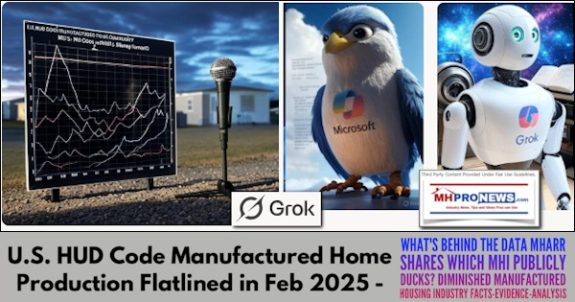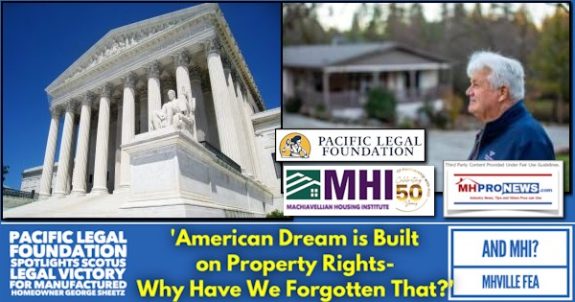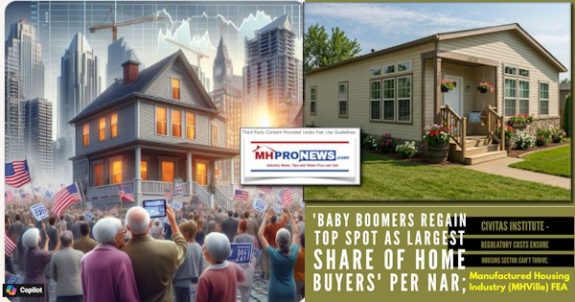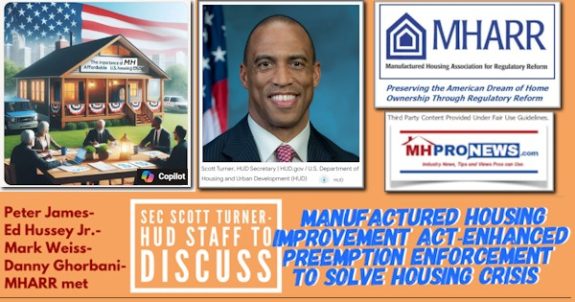MHI News
House Financial Services Committee Approves PATH Act; Provides Manufactured Housing Industry Boost to Dodd-Frank Relief Efforts
On July 24th, the House Financial Services Committee approved legislation (H.R. 2767) that reforms the nation’s housing finance system by winding down Fannie Mae and Freddie Mac and replacing them with a secondary market funded entirely by private capital (without a government-funded backstop). The legislation also makes reforms to the Federal Housing Administration (FHA) and makes significant revisions to the Dodd-Frank law (P.L. 111-2030).
The legislation now awaits consideration by the full House, which is expected to take up the bill after the month-long August recess. Senators Bob Corker (R-TN) and Mark Warner (D-VA) have introduced GSE reform legislation (S. 1217) in the Senate, which has yet to be considered by the Banking Committee.
PATH Act Provides Relief to Manufactured Housing Market
The House legislation, known as the PATH Act (Protecting American Taxpayers and Homeowners Act of 2013; H.R. 2767), includes provisions providing lenders and others in the manufactured housing industry relief from a number of Dodd-Frank Act mortgage finance requirements. In particular, the bill includes the reforms outlined in the Preserving Access to Manufactured Housing Act (H.R. 1779) introduced by Reps. Stephen Fincher (R-TN), Bennie Thompson (D-MS) and Gary Miller (R-CA).
Since H.R. 1779 was introduced in late-April, a bipartisan coalition of nearly 45 Representatives have co-sponsored the bill and support continues to grow for the revisions outlined in the measure. Specifically, the PATH Act would:
• Revise the Dodd-Frank Act mortgage originator definition to exclude allmanufactured home retailers and their employees, provided they do not receive compensation from a creditor, lender, mortgage broker, etc.
• Eliminate the Dodd-Frank Act modifications to the Home Ownership and Equity Protection Act (HOEPA), under which a substantial number of manufactured home loans would be considered “high cost” or predatory (the PATH Act provisions go beyond what is proposed in H.R. 1779).
Because of the bipartisan momentum generated for the bill over the past three months, Financial Services Committee Chairman Jeb Hensarling (R-TX) agreed to support the measure to include provisions in larger relief legislation developed by the committee (PATH Act; H.R. 2767).
Despite this accomplishment, assistance is still needed from the manufactured housing industry to continue securing co-sponsors to H.R. 1779 (visit MHI’s issue brief and action alert for more information by clicking here).
MHI thanks industry members and the national network of state manufactured housing associations for their dedicated work to secure co-sponsors and build support for this important legislation.The progress that has been made in advancing manufactured housing provisions through committee has been a direct result of support and co-sponsors garnered for the bill on both sides of the aisle.
Legislative Efforts Aid in Securing CFPB Regulatory Adjustments for Manufactured Housing
As a result of MHI’s and the industry’s efforts to move H.R. 1779 and companion Senate legislation being developed by Senator Sherrod Brown (D-OH) who serves as Chairman Senate Banking Subcommittee on Financial Institutions and Consumer Protection, the CFPB has recently released revised mortgage rules that provide relief to the manufactured housing market in key areas, including:
• Appraisals: the CFPB released supplemental rules (see
Files.consumerfinance.gov f 201307 cfpb appraisal requirement exemptions fr notice) that exempt loans on existing manufactured homes (excluding real estate) from Dodd-Frank appraisal requirements, this is in addition to an existing rule exempting loans on all new manufactured homes (including real estate) from appraisal requirements.
• Loan Originator Compensation: a CFPB modification of loan originator compensation rules (see
http://www.gpo.gov/fdsys/pkg/FR-2013-07-02/pdf/2013-15466.pd
f) now exempts from points and fees calculations the sales price of a manufactured home as well as any commission a manufactured home the retailer pays to its sales persons.
The critical relief granted by the CFPB to the industry in these key areas was a direct result of the industry-wide effort to communicate the importance of preserving access to manufactured housing, as envisioned in H.R. 1779. The legislation served as an effective means of focusing in on the important role manufactured housing plays and that regulatory efforts should be tailored to ensure credit availability for the purchase of manufactured housing is not further deteriorated.
MHI continues to work with Sen. Brown on companion legislation. Given the delicate balance that must be struck between consumer protections and credit access, as well as a near universal fear among Senate Democrats to opening up the Dodd-Frank Act for amendment, a significant amount of time and effort by MHI staff and Sen. Brown’s office has been spent negotiating provisions that will not generate a backlash from Democratic members of the Senate Banking Committee—some of whom (such as Sen. Elizabeth Warren) played an instrumental role in the creation of the CFPB.
PATH Act and Corker-Warner Bill’s Impact on Secondary Market for Manufactured Home Loans
Both S. 1217 and H.R. 2767 would reform the nation’s housing finance system by winding down Fannie Mae and Freddie Mac—over a period of roughly five years—and replace it with an entity that would create residential mortgage securities for purchase by private investors, essentially eliminating the federal government’s role in securitizing home loans. The new entity would be sustained solely by private capital.
The fundamental difference between the two versions is that the Senate bill envisions a governmental backstop in the event of catastrophic losses, but only after private investors and institutions had absorbed losses.
Both measures also eliminate the affordable housing goals of the GSEs. Since the government would not be securitizing mortgages the duty to serve requirements are unnecessary. However, under the PATH Act any residential mortgage eligible to be packaged into a security that would be marketed and sold through the new utility would not be allowed to discriminate based on product type (including manufactured home personal property loans). Open access would be granted to all residential mortgages and priced according to risk.
Under the Senate measure (S. 1217), only residential real estate mortgages conforming to the Dodd-Frank Ability-to-Repay requirements would be eligible for consideration as a “covered security” and qualify for government insurance and issuance through the newly envisioned Federal Mortgage Insurance Corporation (FMIC), which would operate similar to the FDIC.
MHI is working with Senate Banking Committee leaders to ensure that manufactured homes loans secured by personal property would be eligible to participate as a “covered security.”
It is important to note that both pieces of legislation are expected to undergo significant amendment and revision. In addition, regulatory implementation of any housing finance reform law will take place over several years, as the existing GSEs wind down. During this implementation phase ensuring access to manufactured home loan products is most critical.
Further, MHI is working diligently to preserve provisions that provide the manufactured housing industry relief from onerous provisions of the Dodd-Frank Act, while at the same time working to ensure any revised housing finance system provides open access to all manufactured home loans.
For additional background material on the House and Senate bills, see:
• Moody’s analysis of the PATH Act(H.R. 2767)
– House Financial Services Committee summary
• Moody’s analysis of the Corker-Warner Bill (S. 1217)
– Summary outline of S. 1217
– Diagram of structure of FMIC as envisioned in S. 1217
MHI members can contact Jason Boehlert at jboehlert@mfghome.org or (703) 558-0660.
MHI CFPB and Financial Services Updates
Senate Confirms Richard Cordray as CFPB Director
On July 16th, the U.S. Senate confirmed Richard Cordray as Director of the Consumer Financial Protection Bureau (CFPB). The confirmation comes after two years of a Senate Republican filibuster. Senate Republicans had been unwilling to allow Cordray’s nomination to move for a full vote until the administration agreed to make changes to the structure and funding of the agency. In a move that was facing a potential Supreme Court challenge, President Obama circumvented the Senate filibuster and installed Cordray as CFPB Director by means of a controversial recess appointment. Senate Democrats were able to overcome Republican objections by threatening to implement a rules change that would have circumvented the filibuster and required only a majority vote to confirm any executive branch nominee. An array of legal questions regarding the legality of CFPB rulemaking had arisen, which are essentially moot now that Cordray has been officially confirmed by the Senate.
Banking Committee Approves Watt FHFA Nomination
In a 12-10 party-line vote, the Senate Banking Committee approved the nomination of Rep. Mel Watt (D-NC) to become Director of the Federal Housing Finance Agency (FHFA) on July 18th. The nomination now awaits floor action, which could potentially receive consideration prior to the month-long August recess.
FHFA has been without a confirmed director since James Lockhart left the post in August 2009. Then Deputy Director Edward DeMarco took over as acting director and has overseen Fannie Mae and Freddie Mac as they returned to profitability last year.
DeMarco has been criticized by congressional Democrats and housing advocates because he has rejected Obama administration proposals to write down mortgage principal for struggling borrowers who owe more on their Fannie or Freddie loans than their homes are worth.
Under DeMarco’s tenure, FHFA has also failed to implement manufactured housing duty to serve requirements that were enacted in 2008. According to reports, Watt has indicated his support for these requirements in private meetings with Democratic Senators.
Republicans have been critical of Watt’s nomination citing a lack of technical expertise and his support for principal reductions.
GAO to Review CFPB Data Collection
In response to a request from Senate Banking Committee Ranking Member Mike Crapo, the Government Accountability Office (GAO) will begin a formal review of the CFPB’s data collection activities. Documents obtained through a Freedom of Information Action (FOIA) filed by Judicial Watch, a government watchdog group, show that the CFPB aspires to track the financial records of five million Americans. The CFPB acknowledged the program in testimony provided to the Senate Banking Committee.
An outline of the program obtained by Judicial Watch shows that the CFPB plans to use credit information from a large pool of consumers “in a wide range of policy research projects.” “The data panel shall include five million consumers, and joint borrowers, co-signers, and authorized users. The initial data panel shall contain 10 years of historical data on a quarterly basis,” the guidelines say.
Contractors selected by the CFPB “shall provide a persistent consumer identifier making it possible to follow consumers over time,” the document says. Among the uses of the data will be “surveys on particular products.”
For more information, click here.
CFPB IG Legislation Introduced
Senator Rob Portman (R-OH) recently introduced legislation (S. 1310) to create a dedicated, Senate-confirmed Inspector General (IG) for the CFPB. Under current law, the CFPB has to share an IG with the Federal Reserve. Unlike most major agency IGs, the Federal Reserve IG is a “designated federal entity IG” hired by the Fed Chairman, rather than appointed by the President with the advice and consent of the Senate. For more information,click here.
Legislation to Recreate Glass-Steagall Introduced
On July 11th, Sen. Elizabeth Warren joined with Sens. Maria Cantwell (D-WA), Angus King (I-ME) and John McCain (R-AZ) to introduce legislation (S. 13100) that would break up the biggest banks and force a separation of trading and banking activities, in effect reintroducing the Glass-Steagall Act. According to a release from Sen. Warren, the original Glass-Steagall Banking Act of 1933 was introduced in response to the crash of 1929. Beginning in the 1980’s the Federal Reserve Board and the Office of the Comptroller of the Currency reinterpreted the law that “broke down” the core functions of the legislation, which was to minimize risk by erecting a wall between investment and depository banking. With the passage of Gramm-Leach-Bliley in 1999, the Act was effectively repealed.
While the measure is opposed by the administration and is not expected to receive floor consideration, it does serve to underscore the significant distrust that still resides in Washington, DC and the rest of the nation for larger institutions in the financial services sector that played a role in the collapse of the housing market.
For more information, click here.
FDIC Resources on Capital Rules
The Federal Deposit Insurance Corporation (FDIC) provides resources to assist banks and other depository institutions in understanding new capital reserve requirements. These resources are part of a broader FDIC outreach effort to help banks prepare for these new requirements. For more information, click here.
Free Webinar on TILA Rescissions
On August 13th, Ballard-Spahr will hold a free webinar on how lenders can limit their exposure to TILA rescission demands. During the webinar, legal experts will cover:
• The process of TILA rescission,
• The core considerations for responding to TILA rescission demands,
• The information required to properly respond to TILA rescission demands,
• Effective steps for limiting exposure,
• Dealing with delayed rescission situations,
• Changes in the legal landscape, and
• The impact on CFPB examinations.
The webinar will take place at 12:00 pm (ET) on August 13th. To register or for more information, click here.
MHI President and CEO Meets with FHA Commissioner Carol Galante
On July 22nd, MHI President and CEO, Richard Jennison met with FHA Commissioner and Assistant Secretary for Housing, Carol Galante to discuss MHI’s HUD priorities. Following are highlights of the meeting.
Non-Career Administrator
Jennison thanked the Commissioner for her recent actions to appoint an Administrator for the Manufactured Housing Program. MHI strongly recommended that HUD consider Victor DeRose as a candidate for the HUD Administrator position which is the candidate that MHI & MHARR jointly endorse.
While she said she understands that the industry wanted a non-career appointment rather than a permanent position, the Administration’s policy has been to fill “political” or non-career positions with permanent positions for programs like the Manufactured Housing Program that benefit from consistency and staff stability.
In spite of the federal budget sequester and the hiring freeze, she was able to obtain approval to fill the position from outside the federal work force because the manufactured housing program is important to HUD’s overall mission to address the nation’s affordable housing needs. She noted that the Manufactured Housing Program has been neglected for too long and she would like to change this. She would like to see the office of manufactured housing work more closely with the various FHA loan program offices in single and multifamily housing. She hopes to have the position filled by the beginning of the next fiscal year or sooner. According to Ms. Galante, there are no plans at this time to re-organize the Manufactured Housing program within the Office of Risk Assessment and Regulatory Affairs, but will reconsider if it is necessary in the future.
Trade Association Representation on the Manufactured Housing Consensus Committee
Jennison requested that HUD reconsider its policy not to appoint representatives from the industry’s trade association to the Manufactured Housing Consensus Committee (MHCC). Ms. Galante said she would have the new Administrator review the current policy.
Preemption
Galante said she understands the benefits of a uniform preemptive building code and indicated the need to update the outdated 1997 policy on zoning, noting that the Department just finished updating a number of 40 year-old FHA policies, guidelines, etc.
Financing
Jennison said that MHI has been in discussions with HUD staff about the continuing need to streamline regulations and guidelines under the FHA programs, particularly requirements for installation of manufactured homes under the FHA (203)(b) mortgage insurance program. He briefed the Commissioner on MHI’s efforts to obtain relief from the Consumer Finance Protection Bureau and reiterated MHI’s request for changes to the lender net-worth and capital risk requirements under the Government National Mortgage Association (Ginnie Mae) Program.
MHI Submits Comments on Energy Efficiency Standards for Manufactured Housing
On July 25th, MHI submitted comments to the Department of Energy’s (DOE) Request for Information (RIF) regarding energy efficiency standards for manufactured housing. DOE issued the request because of deficiencies in the draft proposed rule raised by industry and other stakeholders pending at the White House Office of Management and Budget since December 2011.
DOE requested information on indoor air quality, financing and related incentives, and model systems of enforcement and compliance. MHI addressed several issues in comments submitted in response to DOE’s 2010 Advanced Notice of Proposed Rulemaking (ANOPR) and provided additional information in its July 25th comments.
Following are highlights of MHI’s comments:
• DOE must consider the need to balance the congressionally mandated requirement to reduce homeowner energy costs and at the same time ensure that manufactured housing remains affordable. Manufactured housing’s importance as a sustainable source of affordable housing is reinforced by data indicating that in 2012 it accounted for 73 percent of all new homes sold under $125,000.
• Significant constraints in homebuyer financing will seriously impact the ability of home buyers to purchase energy efficient manufactured homes. In promulgating new energy efficiency standards, DOE must consider the impact of the current financial climate for manufactured home lending on a consumer’s ability to afford higher home prices resulting from increased energy standards.
• Energy efficiency standards will increase down payment and monthly mortgage costs. While MHI supports efforts to reduce monthly energy costs, we are concerned about typical manufactured homebuyer’s ability to qualify for a home loan to purchase the more energy efficient home. It is these homebuyers who have been most impacted by the economic downturn, and who are still struggling despite hopeful signs of an economic turnaround.
• Financing and other incentive programs have had limited impact. The federal government has a good track record in promoting programs and policies that result in net life cycle cost savings to consumers but is less successful in demonstrating life cycle cost savings to encourage low and moderate income buyers to purchase an energy efficient home.
• Energy Efficient Mortgages are not widely available for manufactured home buyers and therefore should not be used to justify energy efficiency standards that are not affordable.
• The energy conservation standards to be developed by DOE will be most effective if they are incorporated into the HUD code and its uniform enforcement system. DOE should coordinate with HUD and ensure that the energy conservation standards work seamlessly with relevant provisions in the HUD code, recognizing that any changes to the HUD code required by the new energy standards must be reviewed by the Manufactured Housing Consensus Committee. DOE should sign a Memorandum of Understanding with HUD to give HUD the authority to enforce the energy conservation standards.
• In promulgating new energy efficiency standards DOE should recognize that manufactured housing has led the way in adopting building standards and technologies that consider indoor air quality and the need for proper ventilation.
The HUD Code is the only residential building code that contains requirements for mechanical ventilation for formaldehyde emissions. Neither HUD nor the industry have reported problems necessitating additional ventilation requirements beyond the HUD-Code.


























